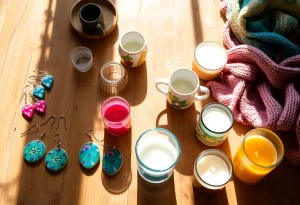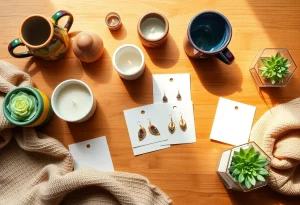Table of Contents
The Growth of Etsy and Handmade Markets
Etsy has become the go-to platform for unique, handcrafted goods. With over 90 million active buyers in 2022, it’s a goldmine for artisans and vintage collectors. The marketplace has seen steady growth, with gross merchandise sales hitting $13.3 billion in 2021.
People are moving away from mass-produced items. They want products with character and stories. This shift has boosted Etsy’s popularity. Let’s look at why handmade and vintage items are so appealing:
- Uniqueness: No two items are exactly alike
- Quality: Often made with better materials and care
- Sustainability: Less environmental impact than mass production
- Personal touch: Direct connection with the maker
Etsy stands out from other e-commerce giants. Here’s how it compares:
| Feature | Etsy | Amazon Handmade | eBay |
|---|---|---|---|
| Focus | Handmade, vintage, craft supplies | Handmade only | All types of items |
| Seller fees | Lower | Higher | Varies |
| Customization | High | Limited | Limited |
For those looking to start selling handmade items, Etsy offers a great starting point. But it’s not just about listing products. Success on Etsy requires strategy and understanding the platform.
This video offers practical advice for new Etsy sellers. It covers common pitfalls and tips for getting started on the right foot.
As the handmade market grows, sellers need tools to manage their business across platforms. That’s where apps like Marketplace Connect come in handy, helping sellers sync orders and inventory across Etsy and other channels.
Understanding Etsy’s landscape is just the first step. Let’s dive into how you can make your Etsy shop stand out in this thriving marketplace.
Crafting the Perfect Etsy Product Listing
Let’s face it – selling on Etsy can be tough. With millions of handmade and vintage items, standing out takes work. But don’t worry, I’ve got some tricks up my sleeve to help your listings shine.
First things first: your product title. This is your chance to grab a shopper’s attention, so make it count. Use descriptive keywords that clearly explain what you’re selling. For example, instead of just “Vintage Necklace”, try “1960s Turquoise Beaded Choker Necklace – Boho Hippie Style”.
- Include key details like material, color, era, or style
- Keep it under 140 characters
- Front-load the most important words
Next up: pricing. This can be tricky, especially for handmade items. You want to make a profit, but also stay competitive. Do some research on similar items to get a feel for the market. Don’t be afraid to price based on the value of your work – quality craftsmanship deserves fair compensation.
Now for the fun part – photos! High-quality images are crucial for catching eyes and making sales. Natural lighting is your best friend here. Take multiple shots from different angles, and include close-ups of any special details.
This video offers some great insights on selling vintage items on Etsy. It covers pros and cons to help you decide if it’s the right platform for your business.
Mastering Etsy SEO to Boost Visibility
Getting your items in front of potential buyers is key to Etsy success. That’s where SEO (Search Engine Optimization) comes in. By understanding how Etsy’s search algorithm works, you can tweak your listings to rank higher in search results.
- Research relevant keywords using Etsy’s search bar
- Include these keywords naturally in your title, tags, and description
- Keep your shop sections organized and clearly labeled
- Fill out your About page completely – it helps build trust
Etsy’s algorithm takes into account factors like listing quality, customer service, and shop policies. So make sure you’re providing a great overall experience for buyers.
Don’t forget to check your Etsy stats regularly. This data can help you refine your SEO strategy over time. Pay attention to which search terms are bringing in the most views and sales.
Building a Loyal Customer Base on Etsy
Repeat customers are gold in the e-commerce world. To keep buyers coming back, focus on creating a memorable shopping experience.
| Strategy | Benefits |
|---|---|
| Prompt, friendly communication | Builds trust, increases positive reviews |
| Offer personalization | Creates unique products, encourages repeat purchases |
| Start a loyalty program | Incentivizes return customers, boosts sales |
Your brand story is what sets you apart from the competition. Share your passion and process in your shop’s About section. Customers love supporting real people and understanding the work that goes into handmade or vintage items.
Responding quickly to messages and reviews (both positive and negative) shows that you care about your customers. This personal touch can turn a one-time buyer into a loyal fan.
Consider offering custom orders or personalization options. This not only creates unique products but also gives customers a reason to choose your shop over others.
Managing all these aspects of your Etsy shop can be time-consuming. That’s where tools like Marketplace Connect come in handy. It helps streamline order management and inventory updates across multiple sales channels, freeing up your time to focus on crafting and customer service.
Remember, success on Etsy doesn’t happen overnight. It takes patience, persistence, and a willingness to learn and adapt. But with these strategies in your toolkit, you’ll be well on your way to building a thriving Etsy business.
Overcoming Common Etsy Selling Challenges
Selling handmade and vintage items on Etsy can be rewarding, but it comes with its own set of hurdles. Let’s break down some key challenges and how savvy sellers are tackling them.
Inventory management across multiple channels is a common headache. Many Etsy sellers also list on their own websites or other marketplaces. Keeping track of stock levels can quickly become a full-time job. Smart sellers are turning to automation tools to sync inventory across platforms, saving time and preventing overselling.
- Use inventory management software
- Set up low stock alerts
- Regularly audit your inventory
Seasonal fluctuations can make or break an Etsy shop. The key is preparation and diversification. Successful sellers plan ahead for busy seasons and develop product lines that sell year-round.
- Analyze past sales data to predict trends
- Create off-season marketing campaigns
- Develop products for different seasons
Shipping and fulfillment efficiency can set top sellers apart. Streamlining these processes is crucial for maintaining positive reviews and repeat customers. Many are finding success with batch processing and shipping integrations.
Staying compliant with Etsy’s policies is an ongoing task. The platform regularly updates its rules, and keeping up can be challenging. Proactive sellers are:
- Subscribing to Etsy’s seller newsletter
- Joining seller forums for community updates
- Regularly reviewing their shop for policy alignment
By addressing these challenges head-on, Etsy sellers can focus on what they do best – creating unique products. Tools like Marketplace Connect are helping sellers manage multiple channels seamlessly, including Etsy, by automating order syncing and inventory updates. This allows crafters and vintage collectors to spend less time on admin and more on growing their businesses.
Wrap-up
Selling on Etsy can be a great way to turn your passion for handmade or vintage items into a thriving business. We’ve covered a lot of ground, from optimizing your shop to mastering SEO and providing top-notch customer service. Remember, success on Etsy doesn’t happen overnight – it takes time, effort, and a willingness to learn and adapt.
As your Etsy shop grows, you might find yourself wanting to expand to other marketplaces. That’s where tools like Marketplace Connect can come in handy, helping you manage orders and inventory across multiple platforms without the headache.
Whether you’re just starting out or looking to take your Etsy shop to the next level, keep experimenting with your strategies and stay true to your unique style. The world of online selling is always changing, so stay curious and open to new ideas. Who knows? Your next big seller might be just around the corner.
Got questions about selling on Etsy? Check out our FAQ section below for quick answers to common concerns.
Frequently Asked Questions About Selling on Etsy
How much does it cost to start selling on Etsy?
Starting an Etsy shop is free, but there are some fees to consider. It costs $0.20 to list an item for 4 months. When you make a sale, Etsy takes a 6.5% transaction fee plus a 3% + $0.25 payment processing fee. Keep in mind, you’ll only pay these fees when you actually sell something.
What types of items sell best on Etsy?
Etsy is known for handmade, vintage, and unique items. Some popular categories include:
- Jewelry and accessories
- Home decor and furniture
- Art and collectibles
- Craft supplies
- Clothing and shoes
The key is to offer something unique or personalized that shoppers can’t easily find elsewhere.
How can I protect my designs from being copied?
While it’s challenging to completely prevent copying, you can take steps to protect your work:
- Watermark your photos
- Use low-resolution images for listings
- Register copyrights for original designs
- Include copyright notices in your shop policies
Remember, your unique style and craftsmanship are often your best protection.
Is it possible to sell on Etsy full-time?
Yes, many sellers make a full-time income on Etsy. Success depends on factors like product quality, marketing efforts, and customer service. It often takes time to build a sustainable business. Many sellers start part-time and gradually scale up as they learn what works best for their shop.
How can I manage orders from Etsy and other platforms?
Managing orders across multiple platforms can be challenging. Tools like Marketplace Connect can help streamline this process. It syncs orders and inventory across different sales channels, including Etsy, saving time and reducing errors. You can learn more about this solution at Marketplace Connect on Shopify.
How important are product photos for Etsy success?
Product photos are crucial on Etsy. They’re often the first thing potential buyers see. High-quality, well-lit photos that show your item from multiple angles can significantly boost sales. Consider including lifestyle shots to help customers envision using your product. Remember, your photos should accurately represent your items to avoid returns and negative reviews.





